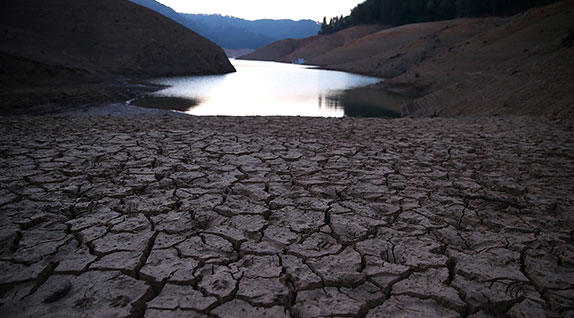 Justin Sullivan/Getty Images
Justin Sullivan/Getty Images
Article
Half of the United States is struggling with extremely dry conditions—with almost 100 percent of California suffering severe drought. It should serve as a wake-up call.
Learn the why behind the headlines.
Subscribe to the Real Truth for FREE news and analysis.
Subscribe NowA Depression-era song brings to mind what Californians may be thinking today: “Don’t you know each cloud contains pennies from heaven?…Trade them for a package of sunshine and flowers. If you want the things you love, you must have showers.”
The world’s eighth-largest economy would love to see such “pennies from heaven” enrich its bare-brown earth and provide the things it loves once again.
Instead the state’s skies are cloudless, its soil parched. Lush lawns have been replaced by brass enclaves of grass, dead almond trees have been ripped out of farms, and livestock struggle in the extreme heat with nowhere to graze. Boating and fishing are out, buying energy-efficient gadgets and finding ways to shorten showers is in. Golf course fairways and polo fields crisp in the sun. Lakes at hotspot tourism destinations have become mere puddles, with some operating at only 20 percent of total capacity.
Now in its third year of heavy drought and 10th dry year in a row, more than 58 percent of California falls into the worst drought-level category—exceptional drought. The area stretches from the second-largest city in the U.S., Los Angeles, through the Central Valley in which 90 percent of the nation’s fruits and vegetables are produced, and up to the mountain peaks of Redding to the north.
The rest of California has been declared a state of emergency as parts of it fit into the “moderate,” “severe” and “extreme” drought-level categories. So far, it has been a $1.7-billion disaster.
Fines exceeding $500 await those who wash a sidewalk or driveway with a hose, use drinkable water in a decorative fountain, or wash a car without a proper nozzle. The state hopes to make a 20 percent cutback on its water usage by urging residents (who use an estimated 80 to 100 gallons of water a day according to the United States Geological Survey) to let lawns go brown and use dishwashers less, among other methods.
The measures, though, are for good reason. In certain areas of the state, the taps have already run dry and relief agencies have been called to bring bottled water to residents whose well water has disappeared. Other Californians have hired well drillers or taken to reporting neighbors to authorities in the hope that this great liquid asset will be available in the future.
Perhaps the worst part of the crisis is that officials have no idea exactly how much water exists in underground aquifers and wells. They can only estimate how much water people use compared to what is currently available through overland lakes and rivers.
“The 2014 drought is responsible for the greatest absolute reduction to water availability for agriculture ever seen, given the high agricultural demands and low streamflows and reservoir levels,” the Center for Watershed Sciences at the University of California, Davis reported. “Surface water availability is expected to be reduced by about one-third.”
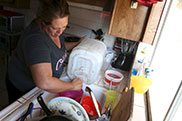 Justin Sullivan/Getty Images
Justin Sullivan/Getty Images
In addition, the center stated: “Net water shortages for agriculture in this year’s drought most severely affect the Central Valley with at least 410,000 acres lost to fallowing, $800 million in lost farm revenues and $447 million in additional pumping costs…Dairy and livestock losses from reduced pasture and higher costs of hay and silage add about $203 million in agricultural revenue losses.”
There is the tendency for those in other parts of the country—and even the world—to become desensitized by the steady stream of bad news coming from the state.
Yet California’s drought has implications for all of us.
Widespread Problem
The entire American Southwest is in the same perilous position as California, though it has not all reached the point of implementing water fines—yet. According to the U.S. Drought Monitor, more than 73 million people—almost a third of the United States—live in a drought-affected area.
Other hard-hit states include Texas, Oklahoma, Arizona, Kansas, New Mexico, and Nevada.
“In six of the seven states with the highest levels of drought, more than 30% of each state was in extreme drought…a more severe level of drought characterized by major crop and pasture losses, as well as widespread water shortages,” USA Today reported.
“Drought has had a major impact on important crops such as winter wheat,” the media outlet continued. “‘So much of the winter wheat is grown across the southern half of the Great Plains,’ [U.S. Department of Agriculture meteorologist Brad] Rippey said, an area that includes Texas, Oklahoma, and Kansas, three of the hardest-hit states. Texas alone had nearly a quarter of a million farms in 2012, the most out of any state, while neighboring Oklahoma had more than 80,000 farms, trailing only three other states.
“In the Southwest, concerns are less-focused on agriculture and more on reservoir levels, explained Rippey. In Arizona, reservoir levels were just two-thirds of their usual average. Worse still, in New Mexico, reservoir stores were only slightly more than half of their normal levels. ‘And Nevada is the worst of all. We see storage there at about a third of what you would expect,’ Rippey said.”
In addition, many Western states are struggling to feed and grow livestock.
“Texas, the country’s leading beef state, lost 24 percent of its total beef herd from 2010 to 2014,” Insurance Journal reported. “Oklahoma saw a 13 percent cut. As a result of shrinking herds, some feedlots and even a meat-packing plant have closed…Hay and alfalfa are expensive and in short supply for feeding cattle. For the time being, dairy producers appear to be absorbing the increased costs, but beef ranchers are having a harder time managing the expense.”
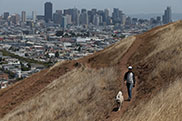 Justin Sullivan/Getty Images
Justin Sullivan/Getty ImagesAccording to National Public Radio, hay prices have increased 200 percent since the drought began.
“Since the price of feeding cattle has skyrocketed, ranchers are culling their herds, selling off large numbers of cattle in auctions to out-of-state buyers. Crops also suffered, as corn outputs fell by 40% in 2011 and peanut production is down as well. The lack of crops has created conditions for severe dust storms across the western part of the state. Rains in 2013 improved the outlook somewhat for agriculture, but drought remained severe in much of the Texas Panhandle [in 2014], an important agricultural region.”
State vs. State
The drought emergency has resulted in Western states fighting over alternative water sources. Oklahoma took Texas to court for trying to divert water and California and Arizona are engaged in ongoing public battles over the Colorado River, which has been declining for some time.
“[The river has] never provided the bounty that was expected in 1922, when the initial allocations among the seven states of the Colorado River basin were penciled out as part of the landmark Colorado River Compact, which enabled Hoover Dam to be built, and the shortfall is growing,” the Los Angeles Times reported.
“The signs of decline are impossible to miss. One is the wide white bathtub ring around Lake Mead, the reservoir behind Hoover Dam, showing the difference between its maximum level and today’s. Lake Mead is currently at 40% of capacity, according to the latest figures from the U.S. Bureau of Reclamation, which operates the dam. At 1084.63 feet…it’s a couple of feet above its lowest water level since it began filling in 1935.”
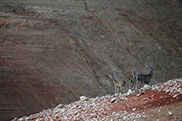 Justin Sullivan/Getty Images
Justin Sullivan/Getty ImagesAnd, according to The Telegraph, the “water crisis in the south west of the US is likely to worsen…Research has found that the Colorado River Basin, the prime source of water in the region, is being sucked dry.”
The outlet continued: “The Colorado River is the only major river in the southwestern US, with the basin supplying water to 40 million people in seven states and irrigating around four million acres of farmland.
“In California, the basin is a key source of water for Los Angeles and San Diego.”
Another study showed the lack of water in the West is most likely the beginnings of a megadrought that could last for the next 35 years and lead to mass migrations of entire Western populations.
“While the 1930s Dust Bowl in the Midwest lasted four to eight years, depending upon location, a megadrought can last more than three decades, which could lead to mass population migration on a scale never before seen in this country,” The Cornell Chronicle reported.
“[Cornell University Assistant Professor of Earth and Atmospheric Sciences and the study’s author Tony] Ault said that the West and Southwest must look for mitigation strategies to cope with looming long-drought scenarios. ‘This will be worse than anything seen during the last 2,000 years and would pose unprecedented challenges to water resources in the region,’ he said.
“In computer models, while the southern portions of the western United States (California, Arizona, New Mexico) will likely face drought, the researchers show the chances for drought in the northwestern states (Washington, Montana, Idaho) may decrease.
“Prolonged droughts around the world have occurred throughout history. Ault points to the recent ‘Big Dry’ in Australia and modern-era drought in sub-Saharan Africa. As evidenced by tree-ring studies, a megadrought occurred during the 1150s along the Colorado River. In natural history, they occur every 400 to 600 years.”
“Beyond the United States, southern Africa, Australia and the Amazon basin are also vulnerable to the possibility of a megadrought. With increases in temperatures, drought severity likely will worsen, ‘implying that our results should be viewed as conservative,’ the study reports.”
Imagine if major metropolitan areas across the nation were inundated with millions of people due to migration! Where would they live? Would there be enough jobs for everyone? How would it affect the infrastructure of those cities?
Complicated Issue
The problem of drought is varied and complex, involving all aspects of modern society. As a result, residents, policymakers, farmers and ecologists are at a crossroads regarding how to solve it.
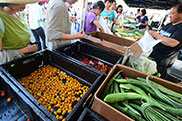 Frederic J. Brown/AFP/Getty Images
Frederic J. Brown/AFP/Getty ImagesSome advocate returning to the area’s natural ecological system. After all, it is argued, California sits on desert land and was never meant to support green grass in its more arid regions. Water actually had to be drained from another part of the state and transported through manmade aqueducts to ensure Los Angeles had drinkable resources. Why should people continue to act as though it is not mostly desert?
On the other hand, California’s Central Valley is home to a $45 billion agricultural industry that provides food for 300-million-plus people. If farmers cannot irrigate their land, they cannot produce crops. It becomes a vicious cycle—no jobs, no crops, no livestock, no food.
“Here in California, we’re the breadbasket of the United States, but also we export tremendous volumes of fruits, vegetables and even cattle overseas,” NASA Jet Propulsion Laboratory climatologist Bill Patzert told Voice of America. “And so when these terrible droughts hit and production drops, this echoes around the globe.”
At the same time, not protecting current ecological systems could mean further depletion of the surrounding area and drying up river beds, resulting in more areas of the West turning to desert—and more problems.
Others are proponents of protecting various animal species at the expense of giving water to farmers. They argue that it forces the agriculture industry to stop turning a blind eye to harmful environmental practices, which includes using pesticides and not restoring sufficient nutrients to the soil.
“Taking more water out of the Delta is not going to solve our problems,” senior attorney with the Natural Resources Defense Council Kate Poole stated. “The emergency drought is a state-wide problem that affects all of us—from farmers to fisherman to the average citizen. And it’s the drought, not the Delta, that’s affecting the water supply this year.”
“While we can’t make it rain, we can take charge of our water use by investing in smart water practices that protect and preserve our water supply…”
The National Drought Mitigation Center described the effects of drought in terms of dominoes: “If those dominoes were drought impacts, the first domino you knock over might be farmers’ corn crops dying. The second domino might be that the farmers would not have money to buy a new tractor from the dealer in town. The dealer would then lose money, which would be the third domino. If enough farmers lose their corn crops, the dealership might not be able to employ as many people or may even have to close down—the fourth domino. The dealership closing would cause many more impacts in the community.”
All of these factors produce a ripple effect with economic, environmental and social implications. This can include energy companies paying more for water and passing on those costs to customers—ships having difficulty navigating waterways to deliver goods and upping the cost of delivery—increases in wild animal attacks because of the need to migrate to urban areas to forage for food—greater possibility of wildfires and the resultant damage to both human and animal habitats—soil erosion—health problems because of decreased water quality and availability—overpumping of aquifers that leads to the sinking of the ground and infrastructure collapse—lack of tourism—and migration of people from rural to metropolitan areas to search for work, among many others.
Unintended Consequences
In a certain sense, we are reaping what we have sown. Though there truly is a lack of rain, the land is also being depleted because many agricultural practices have not focused on protecting arable land, but instead on creating profit. Failing to use cover crops to stop water runoff and replenish soil is not helping either.
Setting aside the debate on global warming, continued drought actually does change the climate.
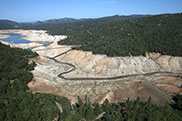 Justin Sullivan/Getty Images
Justin Sullivan/Getty ImagesWhen an area loses its vegetation, which helps to cool the surrounding area and keep soil moist, dirt then becomes as hard as iron. After drying, it turns to powder. With nothing to absorb the sun and lack of vegetation, the temperature of that area naturally becomes warmer.
Think of a desert. The sun’s rays bounce off the nutrient-less sand, heating the earth and producing dust. If there were trees to absorb that sun and provide needed shade to the landscape, it would not feel as hot.
“The increasingly dire water situation across California is being compounded by unusual heat,” The Desert Sun reported. “Long-term weather records maintained by the National Climatic Data Center show that California had its warmest January-June period since record-keeping began in 1895, with the average temperature 4.6 degrees Fahrenheit above average and more than 1 degree warmer than the previous record, set in 1934.”
Water is evaporated by the sun’s rays. If an area does not have vegetation, moisture will be pulled out of it. Dry ground heats up faster than wet ground.
While the Western U.S. is prone to droughts, the overproduction and misuse of the land is intensifying their effects.
“Hotter temperatures worsen droughts by reducing mountain snowpack and causing more evaporation from streams and reservoirs,” the newspaper stated. “Heat also draws more moisture from plants and the soil, and increases the amounts of water needed to irrigate crops and vegetation.”
The same applies to water, which heats up as vegetation around it disappears. Warmer water invites invasive species and promotes the growth of bacteria. This is because flora and fauna, which otherwise balance a natural ecosystem, cannot live in a pesticide-filled body of water or one that has been heated past a certain temperature.
Evidence of this occurred during the summer of 2014 in Toledo, Ohio, and lower Michigan when chemical-and-fecal-matter-laden water runoff led to an algal bloom that rendered water undrinkable for more than 400,000 people during a period of three days.
“The harmful blue-green algae feast on nutrients such as phosphorus and nitrogen, which have been entering Lake Erie en masse recently from farm runoff and sewage-treatment plants. The buildup causes algal blooms, and leads to water that can cause rashes, kidney and liver problems, as well as throw off the ecosystem.”
Imagine such things happening on a grander scale—and in communities across the U.S.—all at once! Prices for products would soar, both in America and across the world, and countries would look elsewhere for goods and services. This would have the potential to tank the American economy and even hamper the nation’s ability to give to others through its many relief programs.
How could the nation continue supporting the annual $38 billion of aid it provides if sustained drought meant the country could not even support itself?
Conditional Arrangement
All of what is happening in the United States is no coincidence. The pennies from heaven that are so needed to enrich the land are no longer falling for a reason.
That reason can be found in a book. That book is the Bible. This text—while ancient—has much more to do with California’s drought than most realize.
Deuteronomy 28 speaks of what God sincerely desires for America, and all nations of the Earth.
The words should be music to California’s ears: “Blessed shall you be in the city, and blessed shall you be in the field. Blessed shall be…the fruit of your ground, and the fruit of your cattle, the increase of your kine [cattle], and the flocks of your sheep. Blessed shall be your basket and your store” (vs. 3-5).
Verse 8 continues that God wants to “command the blessing upon you in your storehouses, and in all that you set your hand unto; and He [wants to] bless you in the land which the Lord your God gives you.”
Then in verse 12 it speaks of opening “unto you His good treasure, the heaven to give the rain unto your land in his season…”
Awesome blessings! Yet they come with a condition, which is stated in verses 1-2: “And it shall come to pass, if you shall hearken diligently unto the voice of the Lord your God, to observe and to do all His commandments which I command you this day, that the Lord your God will set you on high above all nations of the earth.”
The U.S. and other nations must face the fact that they have not obeyed God’s commands. How can this be known for certain?
Read on in verse 15: “But it shall come to pass, if you will not hearken unto the voice of the Lord your God, to observe to do all His commandments and His statutes which I command you this day; that all these curses shall come upon you, and overtake you.”
Notice the result of living contrary to God’s Way—and its integral connection with agriculture: “Cursed shall you be in the city, and cursed shall you be in the field. Cursed shall be your basket and your store. Cursed shall be the…fruit of your land, the increase of your kine, and the flocks of your sheep” (vs. 16-18).
This is not just an indictment of California. The drought is affecting or will soon affect the entire nation. The U.S. must take a serious look at its conduct and the implications its choices have for the rest of the world.
The account continues with another telling consequence for disobedience: “And your heaven that is over your head shall be brass”—no rain!—“and the earth that is under you shall be iron”—severe drought!—“The Lord shall make the rain of your land powder and dust…” (vs. 23-24).
The drought overtaking America, and the nation’s many other problems, should make its citizens stop and examine their conduct and character. They should take a hard look at themselves to know if they are headed down the right path. In fact, unknown to almost all, the Bible devotes many verses to help this modern nation do just that.
For a fuller picture of what is in store for America and its brother nations, read the book America and Britain in Prophecy. Using both the unmistakable facts of history and the power of God’s words in the Bible, it explains what is coming for the U.S.—and the only way the nation can truly solve the scourge of drought.
More on Related Topics:
- Russia, Kazakhstan Evacuate Over 100,000 People amid Worst Flooding in Decades
- U.S. Wildfires Are Getting Bigger and More Complex, Prompting Changes in Firefighting Workforce
- E-waste From Trashed Electric Devices Is Piling Up and Recycling Is Not Keeping Pace, UN Says
- Chemicals in Plastics Far More Numerous Than Previous Estimates, Report Says
- The Plight of Bees and Efforts to Protect Them


